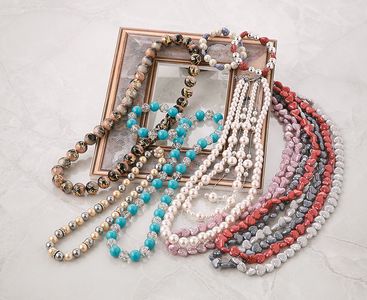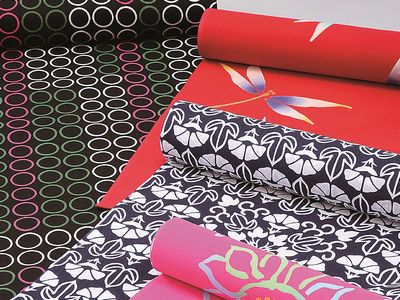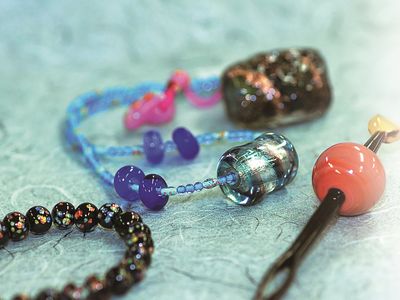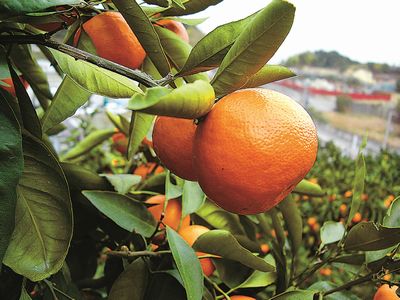Izumi pearls
Imitation pearls are said that those were started by Mr. Tokujiro Oi, who is a trading merchant. He obtained French imitation pearl products in the late era of Meiji. After that he asked Mr. Hiraga Yoshimi, who was the first president of Osaka Commercial Museum, to research it. Izumi pearls were made from glass, which were produced in Taisho period. The one made from plastic was produced later. Now, a pearl nucleus is the same of natural peal and Izumi pearl using the nucleus is called “Shellfish Pearl.” Izumi pearl is well-known as a representative Japanese accessary all aver the world, they create great products with unique sophisticated technological skills. It is highly economical. It became popular in the U.S and Europe first and it became popular all over the world later. Now they are exporting it to all over the world. In response to the consumer-oriented individualization and diversification of fashion trend, they develop various kind of products, such as necklaces, pierces, earrings, tie pins, cuffs, barrette, hair accessaries, bag charms. It suits for both formal and casual, so it is highly praised all over the
world. This many years of skill is also used for room accessaries, such as accessary cases and dolls. Now it has established a strong position.
![]() Izumi no kuni Kankou Omotenashidokoro concierges choices!!
Izumi no kuni Kankou Omotenashidokoro concierges choices!!
Glasswork
In Izumi City, glass craft has been developed since old times and it has become an important local industry today.
Regarding composition surface, soft glass has been used for it. Soft glass has a low melting temperature. So it is inferior in heat resistance and acid resistance, etc., but it is used for Izumi Glass because it is suitable for making crafts. Also, the use of colored glass is one of the features from the point of view of materials. Regarding processing method, first, create a glass bar from raw materials, then melt it and process it. The tip of the glass rod is dissolved in the thermal power, and by hand some crafts are made; such as animal-shaped, ship-shaped and carriage-shaped crafts.
![]() Izumi no kuni Kankou Omotenashidokoro concierges choices!!
Izumi no kuni Kankou Omotenashidokoro concierges choices!!
Cotton and synthetic fabrics in Izumi-city
Senshu region including Izumi-city has been a production area for cotton & staple fiber fabrics from the old time. This area is one of 4 major production areas in Japan; Shizuoka prefecture, Aichi prefecture, Hyogo prefecture and Osaka prefecture. It is said that the famous monk, Kobo-Daishi, had brought cotton seeds from Tang, old China, and planted them in this area. After the Muromachi era, spinning cotton has been started to weave white cotton fabrics. It has been widely known as “Izumi Momen” since the Edo period,
when cotton clothes had been spread to Japan as a part of lifestyle. This area was formed as the center of cotton zone. In the late Meiji period, the traditional looms were gone and power looms were started to use, and later it changed from handlooms to looms with motor by oil and gas. After using electronic in the early Taisho period, it became the origin of the automatic loom today, this industry has rapidly developed since this time.
Cotton product from England had not been imported because of the first World War, so Japanese products monopolized the far east cotton market. Then the industry had achieved dynamic economic development. From the Showa Era, controlled economy has started and the industry was declined. After the World War II, industry of cotton and staple fiber fabrics recovered rapidly, even though other heavy industry and large companies did not achieve the quick reconstruction. It has played a leading role in the establishment and post-war economic reconstruction development of modern industrial society of Japan. Now, many products are produced, such as clothing textiles, bedding materials, industrial materials, other sanitary materials, and white cotton textiles with small width and so on. A huge range of products are woven so we made a big breakthrough as a raw material supplier for domestic market or an exporter to the international market.
![]() Izumi no kuni Kankou Omotenashidokoro concierges choices!!
Izumi no kuni Kankou Omotenashidokoro concierges choices!!
Izumi Tombodama
According to the literature, such as “Japanese Glass Industry History,” in the Nara period, when the Jingu Emperor was on the way back from the conquest of three countries in old Korea, he took technicians of glass beads from Goryeo, old Korea to Japan. At Izumi close to Naniwa court, which is around Sakai city now, technicians brought technology to Japanese. This is said to be the beginning. In the Edo era, the glass ball made in Izumi was famous and it was called “Senshu ball,” or “Sakatombo.” Manufacturing technology of glass beads of today was established in the early Meiji era around in the current Izumi City by a description. The technology was opened to villagers by Mr. Kiyomatsu Kamiyama so the area was developed as a producing area of glass ball.
Mr. Tokiharu Komizo who is the late head of Sangetsu workshop succeeded the technology and produced “Izumi Glass Beads” (Izumi Tombodama). Ms. Yuriko Matsuda who is Tokiharu’s daughter succeeded it. Beautiful colorful 3mm of Izumi glass beads are popular now.
![]() Izumi no kuni Kankou Omotenashidokoro concierges choices!!
Izumi no kuni Kankou Omotenashidokoro concierges choices!!
Izumoku
In recent years, in Osaka Prefecture, some forests are not managed well and the area of it is increasing. One of the reasons is wood products’ price has been low recently.
To solve this problem, Osaka Prefecture and Izumi City have started advancing new measures since last fiscal year to promote the utilization of wood products. One of measures is taking timber out from forest thinning.
Another measure is enhancing the movement to establish a regional brand, “Izumoku Project,” which is aiming at the promotion of “Osaka Certification Timber” and the utilization of timber produced in Izumi City.
“Izumoku,” which is produced in Izumi City, is mainly timber of Cypress, or Japanese cedar. It is used for the building’s structure and wall panels of “Yokoyama Kinomi Day Care Center” and also used for washrooms’ wall panels of elementary and junior high schools in Izumi City.
You can buy some photo flames made by “Izumoku” at Southern Region Center & Roadside Station “Izumi Yamaainosato” or “Izumi City Izumi no kuni Omotenashidokoro.”
Please touch “Izumoku” once because it is said that wood has visual and tactile healing effects so that seeing gnarl on it or touching it makes you relaxed and feel comfortable.
![]() Izumi no kuni Kankou Omotenashidokoro concierges choices!!
Izumi no kuni Kankou Omotenashidokoro concierges choices!!
Agricultural Products
Flowers
Izumi district has an approximately 800 years of history for flower growing. It is said that it was started by Jugen Shunjobo, who had endeavored to reconstruct Todaiji Temple. When he returned to Japan, he took daffodil bulbs with him from Sung, old China, and he introduced how to grow them to the people in Kuwabara district.
Flower growing has been continuing since then. Kuwabara district is suitable for flower growing, especially bulb cultivation. It is because the drainage is quite good in this area because of the sandy soil. Currently, Celosia argentea is cultivating actively as with small chrysanthemum. They also started cultivating new various breed like lily, iris, freesia, aster, lisianthus, and safflower which has high commercial value. They cultivate them in vinyl greenhouses or glass greenhouses so that people passing by them have fun with seeing flowers.
They entertain the eyes of people as urban oasis.
Oranges
Oranges are grown mainly in hill areas in the southern part of Izumi, which is known as the largest orange-producing district in Osaka prefecture. In recent years, Multi-Growing (spreading sheets that reflect sun light on the ground) is introduced to produce high-quality oranges. Thus, oranges are fully ripened with ample sun light so they are favorably reputed for their well-balanced taste of sugar and acidity and it matches consumers needs.
Strawberry
Approximately 46,000 plants of strawberry are grown in Kansai’s largest vinyl plastic greenhouses. Utilizing suburban location conditions, the strawberries are widely popular as oversized, fully ripened ones with high sugar content. Growing strawberries in high-raised platforms without the need for bending down to pick them up is introduced, which enjoys a favorable reception for easy pickup with sure foothold and without soiling your clothes.
Wild yam, Zinenjyo
Wild yam, Zinenjyo, is a kind of wild plants of yam family. Wild Zinenjo grows naturally in a mountainous district. It is said that growing wild yam is difficult. It is not easy to eat natural wild
yam these days.
It came to be known for local specialty of Izumi-City, after they succeeded to cultivate using the pipe for the first time in Osaka.
Strong stickiness is characteristic of wild yam which is effective for nutritional enhancement and praised as the king of the mountain vegetables. “Mugitoro” and “grated yam soba” is popular way of eating.
“Izumi no Sato” product
“Izumi no Sato” is an agricultural corporation, which was established in April, 2001. It was the first agricultural corporation which was established in Osaka prefecture by female farmers. They sell agricultural products directly to consumers and producing additive-free foods with the aim of responsible management. It has attracted attention for the place where female famers work with vigor and enthusiasm.
![]() Izumi no kuni Kankou Omotenashidokoro concierges choices!!
Izumi no kuni Kankou Omotenashidokoro concierges choices!!








